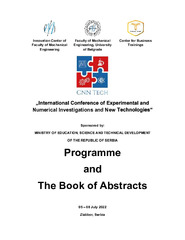Приказ основних података о документу
Numerical Method for Workspace Determination of Flight Simulator with Stewart Platform Mechanism
| dc.creator | Petrašinović, Miloš | |
| dc.creator | Grbović, Aleksandar | |
| dc.creator | Petrašinović, Danilo | |
| dc.creator | Raičević, Nikola | |
| dc.creator | Petrović, Mihailo | |
| dc.date.accessioned | 2023-03-10T20:38:53Z | |
| dc.date.available | 2023-03-10T20:38:53Z | |
| dc.date.issued | 2022 | |
| dc.identifier.isbn | 978-86-6060-120-1 | |
| dc.identifier.uri | https://machinery.mas.bg.ac.rs/handle/123456789/5737 | |
| dc.description.abstract | One of the most important characteristics of the mechanism used for flight simulation is its workspace. The workspace of any mechanism (including parallel mechanisms, which has a closed kinematic chain) is a set of positions and orientations reachable by its end-effector. In order to be able to successfully simulate flight with a motion platform, on which the pilot sits while in training, its workspace has to meet some criteria. Based on previous, it is essential to have a computationally fast and efficient but at the same time also accurate workspace determination process in order to design and optimize the geometry of the mechanism used for the flight simulator. Full flight simulators are most often with parallel mechanisms based on the Stewart platform which has six degrees of freedom inside the workspace. There is no analytical solution for the workspace of this type of mechanism that considers all constraints (such as motion limits of joints) and that can be practically used in the design process. One option is to simply test all significant positions and orientations, this includes defining the range for each axis and value change step (increment between consecutive values) and then testing all possible combinations. In order to lower the number of combinations that must be tested space is divided a few times, first with the coarser step and then with the finer one just around the boundary of the workspace. The final step is defining the boundary surface based on points that are within the workspace. | sr |
| dc.language.iso | en | sr |
| dc.publisher | Innovation Center of Faculty of Mechanical Engineering | sr |
| dc.rights | openAccess | sr |
| dc.source | International Conference of Experimental and Numerical Investigations and New Technologies – CNN TECH 2022 | sr |
| dc.subject | Flight simulator mechanism | sr |
| dc.subject | Numerical workspace determination | sr |
| dc.subject | Stewart platform workspace | sr |
| dc.subject | Parallel robot workspace | sr |
| dc.subject | Space division | sr |
| dc.title | Numerical Method for Workspace Determination of Flight Simulator with Stewart Platform Mechanism | sr |
| dc.type | conferenceObject | sr |
| dc.rights.license | ARR | sr |
| dc.rights.holder | 2022 International Conference of Experimental and Numerical Investigations and New Technologies – CNN TECH 2022 | sr |
| dc.citation.epage | 43 | |
| dc.citation.spage | 43 | |
| dc.identifier.fulltext | http://machinery.mas.bg.ac.rs/bitstream/id/14017/Numerical_Method_for_Workspace_Determination_of_Flight_Simulator_with_Stewart_Platform_Mechanism.pdf | |
| dc.identifier.rcub | https://hdl.handle.net/21.15107/rcub_machinery_5737 | |
| dc.type.version | publishedVersion | sr |


